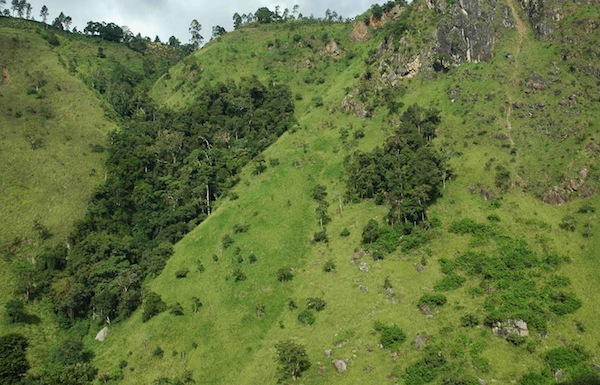According to the FAO, 28.8% or about 1,860,000 ha of Sri Lanka is covered by trees. Of this only 9.0% (167,000) is classified as primary forest, the most biodiverse and carbon-dense form of forest. This should be a shameful statistic for a country that sells itself as a ‘biodiversity hotspot’. The rest is degraded forest, plantations and home gardens. With 185,000 ha of planted monoculture tree plantations, the country has more plantations than primary forest. These timber plantations have none of the attributes of the native forest, they are a veritable desert in terms of biodiversity, but claimed by ‘foresters’ to be a replacement for the lost forests.
But only 9% primary forest? Should this not be a cause for national alarm? We claim to be a ‘biodiversity hotspot’ and we have only 9% of our primary forests to protect this biodiversity.
The tragic reality of this much vaunted boasting about our biodiversity ‘hot spot’ claims, is that many of the endemic species are found in the small forest patches, which represent the only remaining habitat for many rare, indigenous or endangered species. These patches are the small bits of forest that remain on steep or inaccessible parts of the rural landscape. These forest patches have, in most cases escaped the axe and plow due to the fact that they were difficult to access, but with an increase in land hunger and political corruption, they too are being targeted for destruction. As these ecosystems exist as small patches (0.5 – 10 ha) of refugial forest scattered over the landscape they are often not identified for protection, the formal system of protection usually being extended to larger areas. For instance, the cataloguing system of the World Conservation Monitoring Center (WCMC) only considers scheduled forest over 50 ha. Thus most remnant forest patches go unrecognized because they are not a part of any scheduled or protected area.
The small forest patch on many Sri Lankan landscapes usually represents the only habitat for rare, indigenous or endangered species. Further, the ability of the areas presently scheduled or under protection is unable to provide habitat for all the species represented in Sri Lanka. This is due to the fact that there are many different ecosystems arising from past geologic history, that lie outside currently scheduled areas. Many of these ecosystems exist in small patches of refugial forest, which are scattered over the landscape and not identified for protection. These remnant forest patches have to be catalogued and addressed if any potential for future biodiversity conservation and ecosystem rehabilitation work is to be retained.
One technique to address this problem is the Tropical Forest Register (TFR) or similar database that can be cross-linked with the relevant agencies. This action is made even more urgent due to the emerging water problems. In the mountain areas many small refugial forest patches were associated with wetlands or ‘wet patnas’. These provided the life giving dry weather flow of the mountain streams. Today this flow is being systematically diminished by the loss of these refugial forests. The dry weather flow from our mountains was effectively cut when these forest patches and wet patnas were handed out for ‘vegetable cultivation’ by politicians of various colours . To grow potatoes or other vegetables in wet soil, you have to first drain and dry it, an action that robs the downstream areas of their dry weather flow. Next timber and firewood is extracted from the small forest patch with its refugial biodiversity, is but a matter of time, usually short, from these activities to complete clearing
It has long been known that, forests also help control flood events by holding rainwater in the soil and releasing it slowly rather than have the rainfall rush down unprotected hillsides to create floods at every strong rainfall event. The loss of the mountain forests increases the flood events downstream.
The forests are not just repositories of biodiversity; they are also critical contributors to the atmospheric water reservoir. Through the action of photosynthesis a hundred molecules of water are released for every molecule of carbon fixed. Sri Lanka’s forests contain about 61 million metric tons of carbon in living forest biomass, or about 6.1 million tons of photosynthetic biomass. Thus the forests of Sri Lanka releases over 600 million tons of water into the atmosphere annually, cleaned of impurities and contributing to rainfall over the island.
It is this hydrological activity of a forest, its capacity to contribute to and retain local rainfall that makes it so valuable to the nation. In a time of increasing climate insecurity the water functions of a forest must be recognized as a critical national need.
Thus conserving the existing forest patches and reclaiming the montane wetlands becomes a national priority in terms of biodiversity conservation and water management. It requires an integrated approach that includes forestry, wildlife, agriculture and water resources. The will to act in a coordinated manner by the organizations concerned, will determine the future of these aspects in our nation.
